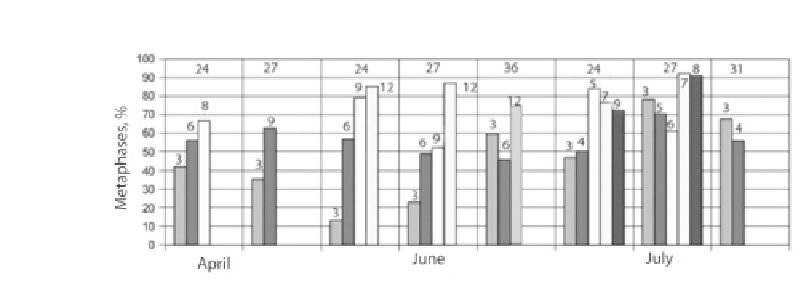Agriculture Reference
In-Depth Information
FIGURE 24.2
Mitotic activity in the cells of plantlets of
Crepis capillaris
after treatment
of seeds by
phosphemid in a concentration 2 × 10
−3
M. Harvest 1967. Plantlets took away for
sprouting at 24, 27, 31, and 36 h after their appearance. Then, plantlets analyzed at different
times after that during 3-12 h (numerical symbols over columns). Analysis was performed in
April, June, and July 1968.
The time after the soakage of seeds was 24, 27, and 36 h. Plantlets are fi xed at 3,
4, 5, 6, 7, 8, 9, and 12 h (numerals over columns) after arising of plantlet. Data are
statistically signifi cant.
Thus, the later the cell enters into mitosis, the longer the synthesis of DNA will
undergo the effect of mutagen in cells.
The high dose 1 × 10
−2
M
of phosphemid is injuring the chromosomes, consider-
ably stronger on the background of the decline of number of plantlets with metaphas-
es. In 72 explored plantlets, 771 metaphases were observed; in 166 (22%) of them,
rearrangements were observed. In 22 metaphases, plural breakages of chromosomes
were observed. Frequency of plural breakages increased with the increase of term of
fi xation. 24 h after plantlet more than 21 percent metaphases contained plural break-
ages of chromosomes.
Besides the large number of breakages of chromosomes the high doses of phos-
phemid resulted in abnormality of spindle of division. It also confi rms that mutagen is
interlinked with the proteins of cytoplasm.
Rapoport, discoverer of the method of chemical mutagenesis, proved that chemi-
cal compounds—ketonic connections, aldehydes, ethylene imine, and others interact
with the proteins of cytoplasm and chromosomes. His experimental data and theoreti-
cal conclusions were published in a number of articles, which now are united in the
edition of the “Discovery of Chemical Mutagenesis” [13].
Probably, phosphemid cooperates with proteins by means of two groups of ethyl-
ene imine. In addition, the pyrimidine in its structure can be included in the structure
of chromosomes at the time of the synthesis of DNA. Moreover, phosphemid not only
causes rearrangements of chromosomes, but it is also repress mitosis in cells, and id
est. affects proteins of spindle of cell division. It becomes apparent under the infl u-
ence of the high doses of phosphemid, leading to plural chromosomal breakages and
the conglomeration of chromosomes in the form of “stars” in the center of cell. The
authors of Ref. [14] determined the number of nuclei labeled by H
3
-thymidin and the
number of labeled mitosis in plantlets after treatment of dry seeds by Н
3
-thymidin















Search WWH ::

Custom Search